XF's ![]() Faceting Properties allow users to control a part's facet quality by adjusting either the surface tolerance or the normal tolerance. This capability helps create geometry that accurately represents the intended surface by smoothing its appearance.
Faceting Properties allow users to control a part's facet quality by adjusting either the surface tolerance or the normal tolerance. This capability helps create geometry that accurately represents the intended surface by smoothing its appearance.
Background
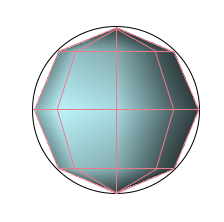
XF—like many CAD-based software packages—maintains two expressions of three-dimensional geometry: backend and frontend. The backend consists of the geometry's analytic definition, for example a sphere with a radius of 1 mm. XF's rendering algorithm uses polygonal surfaces, called facets, to transform the analytic definition into the frontend visualization displayed in the geometry window. Because facets are discrete, smaller ones produce a more accurate representation of the analytic definition. The facet size can be controlled in XF using the surface tolerance and normal tolerance settings.
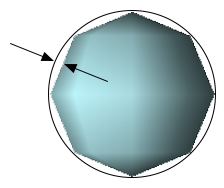
The surface tolerance value is the maximum spatial difference between a facet and the analytic surface definition it is representing. This distance determines how closely the model resembles the true surface, and can be adjusted to either improve or diminish the facet quality. A larger value increases the distance between the faceted part and the analytic surface, producing a low-quality rendering and a rough surface. A smaller surface tolerance refines the facets, resulting in high-quality rendering and a smooth surface.
Users can adjust the surface tolerance using the two available modes to enter either a pure number value or a fractional value of the diagonal length of the face being faceted. The pure number mode allows the user to specify the tolerance as a distance. This produces a number of facets that is dependent upon the model size, so a larger model will contain a greater number of facets. For example, a sphere with a radius of 5 mm will have more facets than a sphere with a radius of 1 mm using the same value, however the smaller sphere will appear rougher.
The relative to body diagonal mode allows the user to specify the tolerance as a ratio. This results in a number of facets that is independent of the model size, so the number of facets and their pattern remain the same regardless of whether the model changes in size. For example, a sphere with a radius of 5 mm will have the same number and pattern of facets as a sphere with a radius of 1 mm.
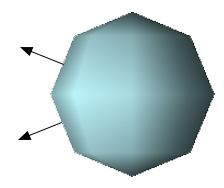
The surface normal is a vector that is perpendicular to the facet, so the angle separating the normals of two adjacent facets will shape the model's surface, as shown in Figure 3. The normal tolerance value sets the maximum allowable angle between these normals, and either refines the geometry or increases its roughness as it decreases or increases, respectively. Because this parameter is independent of the model size, a smaller angle will produce a greater number of facets. Reducing this angle draws adjacent facet normals toward each other, widening their shared interior angle and smoothing the model's surface. The resulting geometry more closely resembles the intended surface. Increasing this tolerance value pushes adjacent normals away from each other, narrowing their shared interior angle and creating a rough surface.
Controls
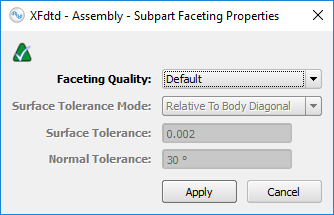
XF's faceting properties offer four faceting quality settings that can be applied to new parts, existing parts, or an assembly of parts: default, medium, high, and custom. The default setting is appropriate for the large majority of cases, although certain modeling problems may require specific parameters to be changed. Choosing either medium or high as the faceting quality will produce finer, more precise geometry.
The custom setting allows users to manually enter a normal tolerance value, or adjust the surface tolerance by selecting a mode and specifying a value.
New Part Faceting Properties can be accessed through the Project Properties Editor, and the settings will be applied to any part created after those specifications have been saved.
Access these faceting properties by selecting Edit ❯ Project Properties, then under the Advanced tab, find the New Part Faceting Properties group in the lower-left corner of the editor.
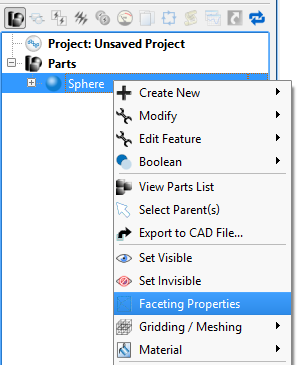
The Faceting Properties Editor is available through the right-click menu of an individual part. Users can right-click on a part in the Project Tree, select Faceting Properties, then adjust the necessary settings in the editor that opens.
The Faceting Properties Editor also includes the Copy to Clipboard function, which allows properties to be transferred to another part by right-clicking on the desired part, selecting Edit, then Paste.
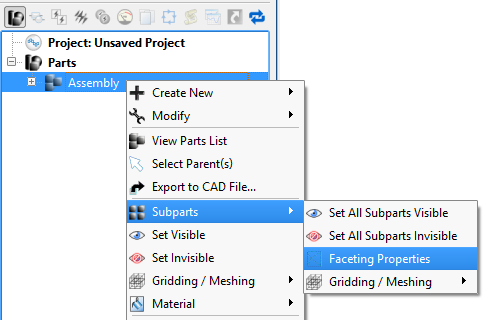
Users can also set faceting properties through the right-click menu of an assembly by right-clicking on the desired branch and selecting Subparts ❯ Faceting Properties. Faceting properties specified that the corresponding window will be applied to all parts within the assembly.

The faceting properties column in the Part's List provides one of the following indicators for each part's faceting setting:
- D: Default
- M: Medium
- H: High
- C: Custom